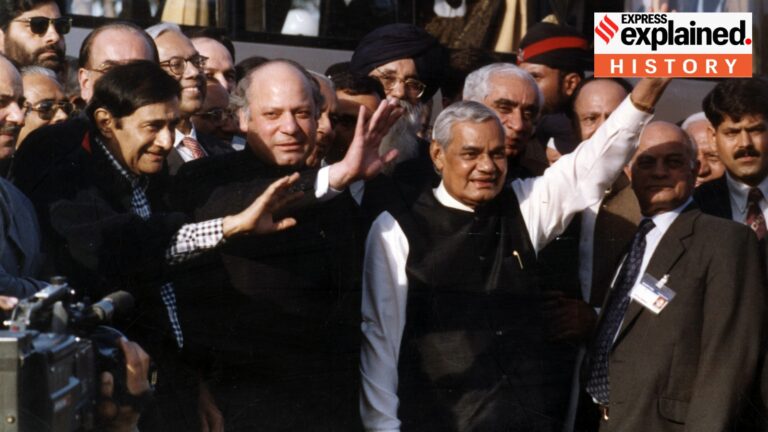“On May 28, 1998, Pakistan conducted five nuclear tests. After that, Vajpayee Saheb came here and made an agreement with us. But we violated that agreement… it is our fault,” Sharif told a PML-N general meeting which he was also present at. He was elected president of the ruling party..
Sharif and Vajpayee after the Indian Prime Minister signed the Declaration on February 21, 1999.‘Their historic bus journey took them to Lahore, but as they shook hands, Pakistani forces were occupying an unmanned high-altitude Indian position in Kargil, Ladakh.
Here’s what happened.
After nuclear tests, Vajpayee-Nawaz parties seek peace
Less than two months after the Vajpayee government came to power on March 19, 1998, India conducted five nuclear tests at the Army’s Pokhran Test Range in Rajasthan between May 11 and 13. Operation Shakti It announced to the world India’s nuclear weapons capability.

Two weeks later, Pakistan responded with its own nuclear test in the Chagai Hills in Balochistan. Suddenly the Indian subcontinent became one of the most dangerous places on Earth. But President Vajpayee had no intention of escalating the situation.
“Now that India, like Pakistan, has achieved nuclear power station status, Atal felt it was time for the two countries to start working towards building good relations,” writes Kingshuk Nag. Atal Bihari Vajpayee: A man for all seasons (2016).

On September 23, 1998, the two governments signed an agreement recognizing the principles of creating an “environment of peace and security” and “the resolution of all bilateral disputes.” This agreement became the basis of the Lahore Declaration.
A historic bus journey across the border
On the afternoon of February 19, 1999, Vajpayee crossed the Wagah Attari border by bus, where he met Nawaz. “This is a defining moment in the history of South Asia and we must rise to the challenge,” Vajpayee told the Pakistani leader (quoted in Kingshuk Nag).
The talks between Vajpayee and Nawaz culminated in the Lahore Declaration, in which India and Pakistan committed to a peaceful resolution of their bilateral disputes, including Kashmir, and to foster friendly commercial and cultural ties. They also agreed to hold bilateral consultations on nuclear policy to avoid an intentional or unintentional nuclear conflict.
But above all, Vajpayee struck a chord with the Pakistani people with his outspokenness and engaging manner. He recited poems (most famously “Ab jun na a honne denge hum(“We will not let war happen”) and noted the common heritage of the two peoples.
During the event at Lahore Fort, the audience was so impressed by Vajpayee’s speech that Nawaz reportedly joked: “Wajipaya supports Pakistan elections (Vajpayee can now win elections in Pakistan too)” (Quoted from Kingshuk Nag)
After the visit, the two countries began further negotiations on the Kashmir issue. For a while, it seemed as though the two countries were finally on the path to a lasting peace. But Pakistan‘Army Chief General Pervez Musharraf thought differently.
The peace process collapses due to Musharraf’s misfortune
Nawaz appointed Musharraf as army chief in October 1998. But unlike Nawaz, Musharraf was not keen on thawing India-Pakistan relations. The army chief was not even present during Vajpayee’s visit to Lahore. In fact, while Vajpayee and Nawaz were shaking hands, heavily armed Pakistani troops disguised as Kashmiri militants were busy crossing the Line of Control to occupy vacant Indian positions in Kargil during the bitterly cold Ladakh winter.
Musharraf wrote in his memoirs: “By the end of April, the 120-km-long open gap across the LoC had been secured by over 100 new posts, each manned by 20 men. The Indians were totally unaware of our new strength along the LoC.”Under Fire: A Memoir2006).
According to former R&AW chief AS Dulat, “Pakistan deployed around 1,500 to 2,400 troops, both regular and irregular, for the Kargil invasion.”Kashmir: The Vajpayee Era2015).
It was only in May 1999 that India began to realise the extent of the infiltration – by which time Vajpayee had been reduced to a caretaker prime minister after losing a confidence motion in the Indian parliament by one vote on April 17 – that India took no firm action.
Indian forces, supported by the Air Force, launched Operation Vijay in May 1999 and recaptured the Kargil Heights by July 26, 1999. Despite a strategic disadvantage (Pakistani forces had occupied the heights) and the harsh conditions of the Himalayas, Indian forces emerged victorious. However, over 500 Indian soldiers were killed and over 1,300 were wounded in the fighting.
And then, as Dulat wrote, “the peace process collapsed.” No further bilateral talks took place between the two countries on Kashmir or any other issue. Within months, Musharraf ousted Nawaz in a coup and took power in Pakistan.



